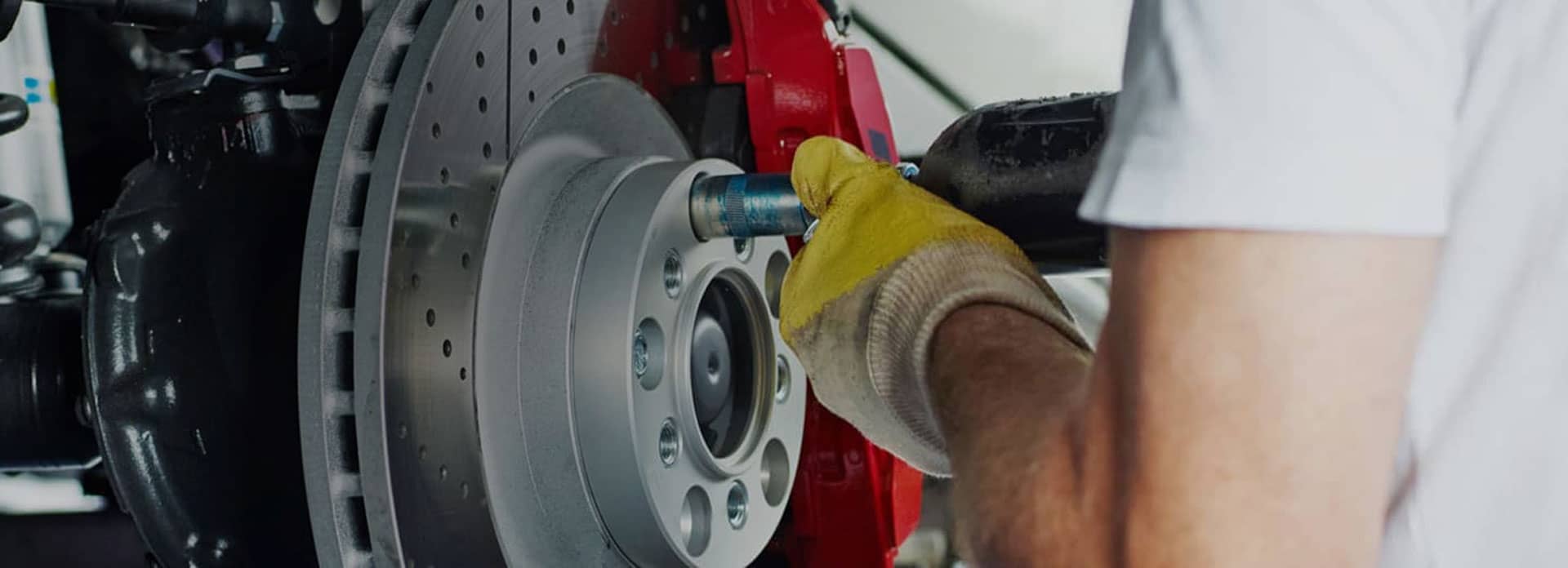
AUTONET TV
Archive for September 2022What Is an EGR Valve? (EGR Valve Service)Posted September 18, 2022 7:05 AMIf you've ever felt your vehicle hesitate, go, then hesitate again, you might think there's something wrong with the transmission. After all, it's not moving smoothly down the road. But there are plenty of malfunctions that can cause those symptoms, one of them being something you may have never heard of: the EGR valve. EGR stands for Exhaust Gas Recirculation. It's a system that channels small amounts of exhaust back into the engine to cool down the cylinders and reduce polluting gases. Those include nitrogen oxides that can cause smog. The EGR valve regulates how much of the vehicle's exhaust gas is recirculated. After years and long distances traveled, that valve can get clogged or fail. Sometimes the EGR valve can stick open. When the EGR valve isn't working properly, your vehicle can start releasing those nitrogen oxides and pollute the air. The symptoms of a malfunctioning EGR valve include:
Depending on its condition, the EGR valve can be cleaned or it may need to be replaced. Consult with your service advisor to see what options are recommended to you. The EGR system is part of your vehicle's pollution and emissions control equipment. If you care about keeping our planet's atmosphere clean, you'll want to make sure it's doing its job—for everyone's benefit. Gilmore's Auto Service Gilmore's Auto Service Automotive Tips: AlternatorPosted September 4, 2022 1:24 AMYour alternator makes electricity to start and run your engine and all of the vital electrical systems in your vehicle. That’s everything from the on-board computers to the turn signals. And of course there is the entertainment system, seat heaters, power windows and everything you plug into the power outlets. After your alternator makes enough electricity to do all that, it recharges your battery with what’s left over. Bad Vibes (Disc brake rotor problems)Posted August 28, 2022 8:48 AMIf you were to name the most important safety feature on your vehicle right now, what would your answer be? A lot of driving experts would agree that it’s your brakes. Most newer vehicles use a well-engineered and efficient style of brakes called disc brakes. The name disc brakes comes from one of the components: a disc attached to the wheel hub that is squeezed by parts called calipers. If you’ve ever ridden a bicycle with hand brakes, you probably have seen how they squeeze against the rim of the bike wheel to stop the bike. It’s similar to the way your vehicle’s calipers squeeze against the disc rotor, with added parts called brake pads attached to the calipers that are what create the friction and stop your vehicle. Here’s why disc brakes need regular maintenance. Over time, that friction creates wear and tear on the brake pads and the rotors, and you’ll start to see the signs. Your brakes may have one of the 3 “S” sounds: squeaking, squealing, or scraping. The sound is usually the first sign of brake pad wear which can lead to rotor damage. Soon you may notice a pulsating or vibration when you brake. That’s because your once smooth and straight rotor disc is warping from the heat generated from friction. Or it may be due to wear. Eventually, your brakes will take a longer distance to stop your vehicle, and the rotors can have grooves carved into them. When you start noticing any of these signs, it’s a good idea to have them inspected by a trained technician. They will measure the rotor thickness, check wear patterns for grooves and heat discoloration, and see how much of the brake pads remain. They will also check to make sure all brake components are moving freely, check your brake fluid, and look for corrosion. Most vehicle manufacturers require worn or damaged rotors to be replaced, not resurfaced. It’s all part of a complete brake job, replacing pads and the brake hardware parts along with the rotors. It reduces the chance of premature failure. How often you will need your brakes serviced depends on the manufacturer’s recommendations, your driving habits, and the environment you live in. Your service facility can recommend the best replacement parts based on those factors. Regular maintenance and attention are vital for keeping your brakes performing like they are designed to. Remember, your brakes are your vehicle’s most important safety feature. Gilmore's Auto Service What is a TPS? (Throttle Position Sensor)Posted August 21, 2022 12:28 PMYou know you have an accelerator pedal; step on it and your vehicle is supposed to go. But did you know there is a part in your vehicle that keeps track of where the throttle is? It's called the Throttle Position Sensor, or TPS. The TPS is a sensor that helps your vehicle figure out the right mix of air and fuel is reaching your engine. It does that by keeping track of the throttle and sending that information to your vehicle's computer. Other factors play a role in how well your engine is performing, including air temperature, how fast the engine is turning over and air flow. When the TPS isn't working right, you may find your vehicle won't accelerate or doesn't have the power you're expecting when you press on the accelerator. In some cases, it may accelerate on its own. Sometimes your vehicle won't go over a certain speed. Your Check Engine light may go on. Any of these symptoms should be checked out soon. If your TPS stops working right, your vehicle may not be safe to drive. Fortunately, most vehicles have a "limp home" mode that will allow you to get off a busy road to a safe spot. Your service advisor can let you know which TPS is the correct replacement for your vehicle. Your shop may have to re-program the new TPS so it works correctly with other software in your vehicle. It's a fact of life these days that computers control many of a vehicle's functions. The sensors that feed information to those computers help make your vehicle work the way it was engineered to and keep you motoring down the road safely and efficiently. Gilmore's Auto Service Steer Clear of Power Steering Problems (Power Steering Maintenance)Posted August 14, 2022 12:51 PMWe usually take our vehicle's easy steering for granted until something goes wrong. Power steering is what makes it almost effortless to turn the steering wheel, aiming your vehicle in the direction you want to go. Without the assistance of power from the engine, steering would be a laborious process, so you want to make sure the system is working well. Power steering systems are usually one of two types, hydraulic and electric. The hydraulic type uses a pump that is driven by either a belt or an electric motor. This system uses hydraulic fluid to create pressure that gives your steering the power assist. Since that pump is always working, time and distance traveled eventually take their toll, and these systems need to be periodically inspected. Also, while that hydraulic fluid can last for years, it should be replaced periodically as it degrades over time. Your vehicle's owner's manual contains the manufacturer's recommendations. A technician can check for leaks in the hoses, pump housing or reservoir. Also, the belts should be inspected and so should the pump, as these can fail. Signs of a failing pump are a groaning noise when you turn the steering wheel, stiff steering, squealing noises when you first start your car and puddles of a reddish-brown fluid under your vehicle. The other type is called EPS, or electric power steering, which is becoming more commonly used in the latest vehicles. It only delivers power assist when you need it and has an electric motor that supplies that steering help. It's more efficient, accurate, compact and clean. And because it has a lot fewer components, it's easier to maintain. If you have electric power steering, you may notice sometimes it's hard to turn the wheel or your Check Engine light comes on. Sometimes the power assist motor fails or there can be problems with electrical connections. Any time you have symptoms, it's important for your safety and that of drivers around you that you have a technician check them out. Properly working brakes are essential for the safe operation of any vehicle. Stop! And make sure yours are working properly.
Power Failure (Broken Power Seat)Posted August 7, 2022 8:09 AMKnow anyone who doesn't love a power seat in an SUV, a car, truck or van? They're convenient and precise in their adjustments. But when they break, oh, what a pain. Not only is it inconvenient, it may leave your seat position too close to the steering wheel or too far from the pedals. This is a must-fix problem. There are many things that cause a power seat to fail:
Most people pay extra to have power seats in a vehicle. So make sure you keep that convenient feature working. And don't forget that it's a safety issue, too. Gilmore's Auto Service Objects in the Mirror (Rearview Mirror Safety and Maintenance)Posted July 10, 2022 10:58 AMYou may remember a song that went, "Objects in the rearview mirror may appear closer than they are." While that was a song about life's lessons, there are a few things we should all know about how important rearview mirrors are to safe driving. While new electronic devices are helping drivers be aware of surrounding traffic in high-tech ways, the good old rearview mirror is still a dependable way of letting you know what's around you. There are usually 3 on each vehicle, 1 attached to the windshield inside and 2 attached outside on each of the front doors. It's important that they be adjusted properly before you start driving (not while you're driving). Experts say the windshield rearview mirror should cover the area behind the vehicle while the outside mirrors should not simply duplicate that view but extend it to the sides, where blind spots normally are. Your rearview mirrors must be able to hold the positions they're adjusted in; it there's play in them or they move around, you'll never be sure they're pointed in the direction that will let you see where traffic is. The one on the windshield must be firmly attached. If it won't stay where you want it, head to your service facility where they can tighten it or replace any parts necessary to let the mirror maintain its aim. If it has fallen off the windshield completely, a technician can reattach it with the proper adhesives or fasteners. There may be electronics that need to be properly connected as well. The outside mirrors cover your blind spots and they must be able to hold their adjustments, too. Many adjust electronically; switches and motors can fail, electrical connections can detach or become corroded and the reflective glass can crack, discolor or develop a hazy fog. A technician can diagnose and repair those problems and recommend any replacement parts you might need. Mirrors that are adjusted manually also should be restored to proper working order in order for you to maintain this important rear visibility. Drivers don't think about their rearview mirrors all that much. On reflection, don't they deserve respect and care for the important job they do? Gilmore's Auto Service Such a Little Part (Climate Control Resistor)Posted July 3, 2022 8:50 AMYou expect your heater/air conditioner to work like it should. You have a control for temperature and one for fan speed. You even have a control for what vents the air comes out of. Don't be surprised one day if your blower fan develops a mind of its own and starts going crazy. Most of the time, you may find that it starts blowing at full speed, and nothing you do to try to control it does any good. This is what may be happening. Your blower motor has an electronic component called a resistor. It does what its name says; it offers resistance. When you want the fan to run more slowly, you turn the fan speed down. That resistor accomplishes that by turning its resistance up. When the resistor fails, the power has nothing to slow it and the fan speeds up. It's a small part and can fail due to age or corrosion. It's usually not an expensive part, either, but it's often found in a location that's not that easy for the technician to get to. That means labor costs will vary depending on the design of your vehicle. Occasionally, a faulty resistor can cause the blower motor not to work at all or only partially come on. But other things can cause that as well, such as a faulty fan switch or vent control. This is where a technician's training comes in. Special equipment can track down precisely where the issue is so you can be assured the correct part is being replaced. It's just not pleasant when the blower motor isn't following orders. Have your service facility check it out so you can be the blower's boss, like it should be. Gilmore's Auto Service Let Gilmore's Auto Service Help You Keep Your Vehicle Another Couple of YearsPosted June 12, 2022 9:55 AMWalnut Creek area residents may remember when the U.S. government's “Cash for Clunkers” program made a splash on the news scene. People were offered incentives to trade in old vehicles for new, in the interest of better and improved air quality from reduced emissions. Gilmore's Auto Service Have a Ball! Know your Ball Joints (Ball Joints)Posted May 8, 2022 9:53 AMWe all have joints in our own skeletal system, but did you know your vehicle has some joints of its own? One of the most important is called a ball joint. One of the interesting things is that it's somewhat similar to the ball and socket joints we have in our hips and shoulders. A ball joint allows two parts it joins together to move in more than one direction at the same time. Think about your wheels. They have to move up and down when there are bumps in the road but in sideways directions when you are making a turn. As you can see, the ball joints are important for your steering and handling to work correctly. Since ball joints do so much, they can wear out and become loose. When the ball wears down or the socket gets worn, there can be too much play in them. It can get so bad that the ball can come out of the socket and your wheel can fall off, a dangerous situation. Ball joints can also seize up. Some of them are sealed and never require maintenance; others require periodic lubrication. Here are some signs that your ball joints are going bad:
The earlier a failing ball joint is discovered, the better. The best way is to have regular inspections by a technician. Your service facility will periodically check ball joints at intervals recommended by the manufacturer. The cost to replace them can vary widely depending on whether you have a vehicle with a 2-ball or 4-ball configuration. Also, sometimes just the joints can be replaced, but other times they are part of a larger control arm assembly that has to have all the parts replaced at the same time. Your vehicle's proper steering, handling and tire wear all contribute to a better, safer driving experience. Make sure your ball joints are up to the job. Gilmore's Auto Service | ||
SearchArchiveJune 2020 (18)July 2020 (4) August 2020 (5) September 2020 (4) October 2020 (4) November 2020 (5) December 2020 (4) January 2021 (6) February 2021 (4) March 2021 (4) April 2021 (4) May 2021 (5) June 2021 (4) July 2021 (4) August 2021 (5) September 2021 (4) October 2021 (5) November 2021 (4) December 2021 (4) January 2022 (6) February 2022 (4) March 2022 (4) April 2022 (4) May 2022 (5) June 2022 (4) July 2022 (5) August 2022 (4) September 2022 (4) October 2022 (5) November 2022 (4) December 2022 (4) January 2023 (5) February 2023 (4) March 2023 (4) April 2023 (5) May 2023 (4) June 2023 (4) July 2023 (5) August 2023 (4) September 2023 (4) October 2023 (5) November 2023 (4) December 2023 (5) January 2024 (5) February 2024 (4) March 2024 (5) April 2024 (4) May 2024 (4) June 2024 (5) July 2024 (4) August 2024 (4) September 2024 (5) October 2024 (4) November 2024 (4) December 2024 (5) January 2025 (4) February 2025 (4) March 2025 (5) | CategoriesFuel Economy (6)Service Intervals (2)Customer Detective Work (1)Steering (5)What Customers Should Know (40)Winter Prep (5)Timing Belt (2)Alignment (3)Maintenance (4)Battery (7)TPMS (1)Dashboard (1)Cooling System (4)Transmission (1)Tires (3)Shocks & Struts (1)Keys to a long lasting vehicle (1)Spark Plugs (2)Oil Change (4)Brakes (2)Air Conditioning (3)Alternator (2)Exhaust (4)Auto Safety (3)Check Engine Light (1)Older Vehicles (1)Brake Service (1)Fluids (3)Fuel Saving Tip: Slow Down (1)Headlamps (1)Tires and Wheels (1)Fuel System (3)Tire Rotation and Balancing (1)Service Standards (1)Engine Air Filter (1)Shocks and Struts (2)Drive Train (1)Inspection (1) | |

OUR REVIEWS


Mary S, 03/07/2025I have been using Gilmore's Auto Service for about 2 years on 2 cars. I am very happy to have found a friendly, knowledgeable and honest car repair service. Recently they did a major rebuild on my 2005 car. Josh was great at explaining the failing issues as well as the expectation of the repairs with no high pressure. The work was completed in great time at a fair price. The car came back to me running smooth and quite, better than I had hoped. It is a great feeling to know I can count on Gilmore's for my automotive needs. Thanks goes out to the Gilmore's team.

Get free Coupons
Take advantage of these great offers!
FREE COURTESY INSPECTION WITH REPAIR
First time customer? Come in for any paid repair work and let Gilmore's inspect your car at no extra cost to you.
No tricks. No Pressure.








